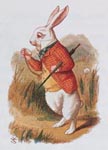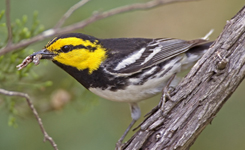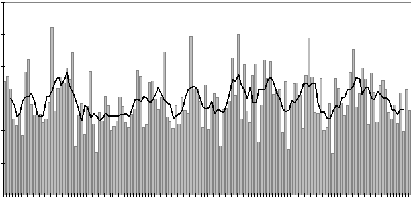
Yes, I know, I'm letting my Disney show through*. But rather than conjuring up a White Rabbit, I'm actually trying to entice home a small bird with bright golden cheeks.
As of this afternoon (5 p.m. on March 10) we had not detected a Golden-cheeked Warbler on the Refuge. I've confirmed through emails and the TexBirds discussion list that the warblers are arriving in the Texas Hill Country.

A birding friend out west of Kerrville heard one outside of his office window on Monday, March 8, at about 3:45 p.m., the first report for Texas this year. At least one was heard in Uvalde County on the 9th, then today there are reports of Golden-cheeks from both San Antonio (to our south) and Fort Hood (to our north). Most of these observers remarked that these first dates are "a little later than usual", which opens up an intriguing topic of discussion: Are migratory birds changing their habits and migration patterns with long-term environmental changes?
Traditionally, March 12-13 had been considered the expected arrival date for Golden-cheeks in the Hill Country, compiled by Warren Pulich from decades of observations up through the mid-1970's. Since the publication of Pulich's work, more and more observers (the cause?) have been reporting Golden-cheeks progressively earlier and earlier (the outcome?). Just a few short years ago, I would have recited March 8 as a more likely first date of observation (by someone somewhere on the breeding range). Most recently, at the risk of speaking for a large group of researchers, we have been only mildly surprised when first reports of the species came on March 4th, 3rd, 2nd, etc. In 2008, Mark Gray established the first February record of a GCWA in Texas with his observation of one arriving in Austin on February 29--but that's sort of cheating since it was a Leap Year. Then came Spring (?) 2009 with a report by Heidi Trudell and Matt York of a male GCWA at Meridian State Park on the "ridiculously early" date of February 27.
It is just so easy and--with apologies to the former Vice President--so
convenient to suggest that changing climate patterns on a continental scale may be enticing Golden-cheeks to arrive earlier and earlier. While that may be the exact, correct answer--if/when we have sufficient data to confirm the pattern--it is crucial to keep in mind that patterns in Nature are never simple. There is variation upon variation. Going back to my surfing analogies, the patterns of changing migration dates, when plotted over time, will begin to look like irregular ripples on top of larger swells, which may or may not have an underlying long-term direction of change. It will look as sloppy as the chart you'd see when plotting long-term rainfall patterns or, gulp, stock market trends. Here are three charts illustrating real world data. One might be rainfall, another the stock market, another may be migratory dates--It's not really important. The nature of *data* is the point I'm making.



Let me quickly say that I am *not* a skeptic when it comes to climate change. We are doing bad things to the global climate and we are seeing symptoms of that in a great many natural history disciplines. Our focal Golden-cheeked Warblers may--just may--be reflecting those directional changes by what we are observing in arrival dates here on the breeding range. It is a wonderfully complex topic to consider what landscape level cues the Golden-cheeks are reponding to; that would be worthy of a couple of Ph.D. dissertations. The present blog is just prompted by the curious and perhaps unexpected warbler timetable we are seeing this season. Last year, they were very early; this year, they are late--by their own standard set in recent years. But today's "late" was yesterday's "early" in a normal year. Have I cleared this up sufficiently?
This topic could not be more timely nor more geographically appropriate:

Secretary of the Interior Ken Salazar will be in Austin on Thursday, March 11 (perhaps the day you are reading this blog) to roll out the latest edition of the "State of the Birds Report", compiled from diverse sources. This year the report will emphasize the challenge of climate change to the conservation of migratory birds.
In the meantime, I've got to get some rest. It will be an early day for me tomorrow--out to the Refuge to try to rope in a Golden-cheeked Warbler to show the Secretary and our other visitors. No pressure! [I am happy to take responsibility for my own actions, but when it comes to predicting the weather or the occurrence of migratory songbirds, I relinquish any responsibility for those events!]
* * * * *
Below The Line:
* I hope I am clear on the difference between Lewis Carroll and Walt Disney. From my recent research, I learned that the famous "I'm Late, I'm Late..." ditty popularized in the early Disney feature of Alice in Wonderland is a paraphrase of the same concept uttered--in different words--by the rabbit in Carroll's novel.
Credit for the White Rabbit thumbnail is as follows: "The White Rabbit, illustration from Alice in Wonderland by Lewis Carroll 1832-98 adapted by Emily Gertrude Thomson, 1889, a painting by John Tenniel." The beautiful Golden-cheeked Warbler male is one of my favorite John Ingram images--Thanks, John. The charts are ripped from random sources via Google Images, stripped of identifying legends on purpose. The pic of Secretary Salazar is, I believe, his official portrait as a member of the U.S. Senate, prior to his appointment as Secretary of the Interior.
